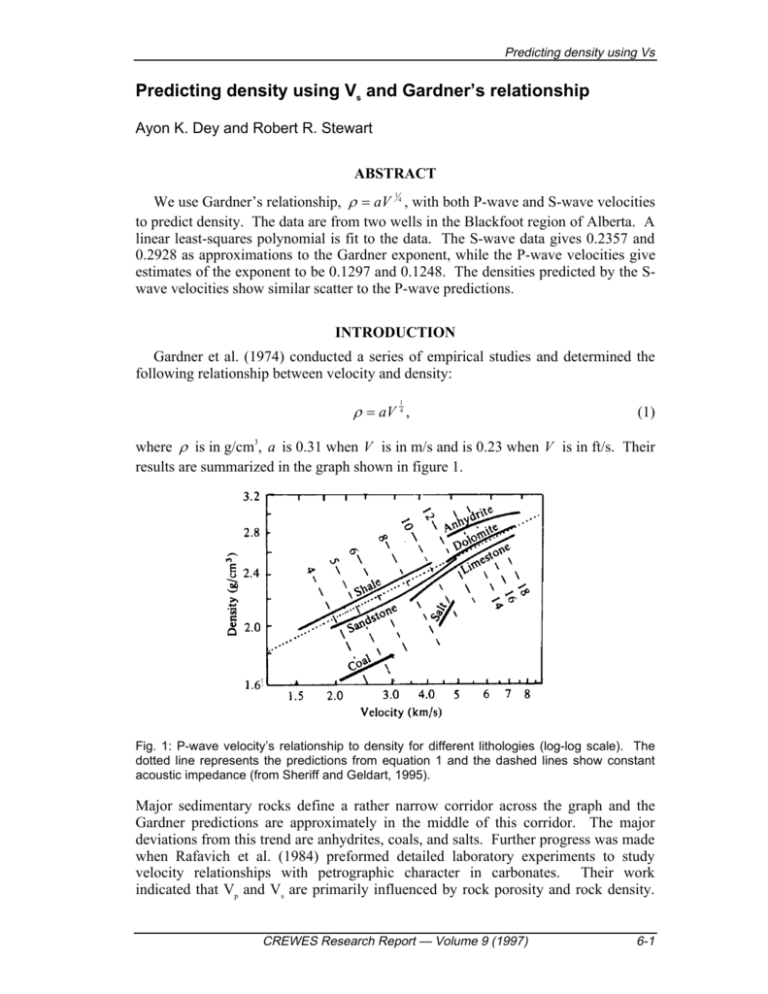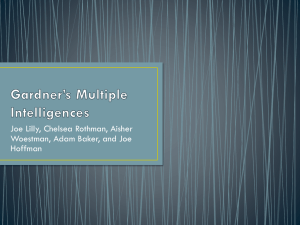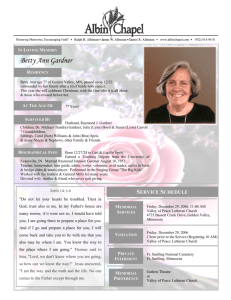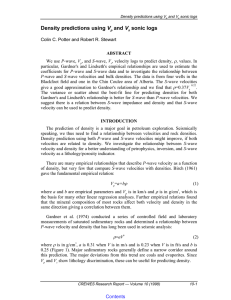Predicting density using Vs and Gardner's relationship
advertisement

Predicting density using Vs Predicting density using Vs and Gardner’s relationship Ayon K. Dey and Robert R. Stewart ABSTRACT We use Gardner’s relationship, U aV 4 , with both P-wave and S-wave velocities to predict density. The data are from two wells in the Blackfoot region of Alberta. A linear least-squares polynomial is fit to the data. The S-wave data gives 0.2357 and 0.2928 as approximations to the Gardner exponent, while the P-wave velocities give estimates of the exponent to be 0.1297 and 0.1248. The densities predicted by the Swave velocities show similar scatter to the P-wave predictions. 1 INTRODUCTION Gardner et al. (1974) conducted a series of empirical studies and determined the following relationship between velocity and density: U 1 aV 4 , (1) where U is in g/cm3, a is 0.31 when V is in m/s and is 0.23 when V is in ft/s. Their results are summarized in the graph shown in figure 1. Fig. 1: P-wave velocity’s relationship to density for different lithologies (log-log scale). The dotted line represents the predictions from equation 1 and the dashed lines show constant acoustic impedance (from Sheriff and Geldart, 1995). Major sedimentary rocks define a rather narrow corridor across the graph and the Gardner predictions are approximately in the middle of this corridor. The major deviations from this trend are anhydrites, coals, and salts. Further progress was made when Rafavich et al. (1984) preformed detailed laboratory experiments to study velocity relationships with petrographic character in carbonates. Their work indicated that Vp and Vs are primarily influenced by rock porosity and rock density. CREWES Research Report — Volume 9 (1997) 6-1 Dey and Stewart Lithology, itself, appeared to have only a small influence as did pore shape and interstitial fluid. GEOLOGY OF THE REGION The log data studied in this report are taken from two wells within the Blackfoot field located near Strathmore, Alberta, in Township 23, Range 23, west of the 4th meridian. Miller et al. (1995) discuss the initial interpretation of this area’s geology. Figure 2 shows the stratigraphy near the zone of interest. Fig. 2: Stratigraphic sequence near the zone of interest (from Miller et al., 1995). 6-2 CREWES Research Report — Volume 9 (1997) Predicting density using Vs Table 1: Major geological formation units near zone of interest (from Potter et al., 1996). ABBREVIATION FORMATION NAME 2WS Second White Speckled Shale BFS Base of Fish Scales Zone VIKING Viking MANN Blairmore-Upper Mannville COAL 1 1 Coal Layer COAL 2 2 Coal Layer COAL 3 3 Coal Layer GLCTOP Glauconitic Channel Top LITHCH Lithic Channel GLCSS Glauconitic Channel Porous Sandstone OST Ostracod SUNB Sunburst DET Detrital MISS Shunda-Mississippian st nd rd RESULTS Tables 2 and 3, modified from Potter et al. (1996), show parameters that are taken from the well log data. This study uses the 12-16 and 9-17 wells from the study area because they have dipole sonics over the interest zone, as well as the complete array of conventional logs. These logs are blocked across the lithological units in Table 1 using MATLAB’s LOGEDIT algorithm with the mean value between the formations used for the blocking. Tables 2 and 3 show a depth value that corresponds to the top of the formation and its interval width. CREWES Research Report — Volume 9 (1997) 6-3 Dey and Stewart Table 2: Log data for various horizons from the 12-16 well (modified from Potter et al., 1996). UNIT DEPTH(m) Vp(m/s) Vs(m/s) U (kg/m3) Above 1229 3562 1837 2512 2WS 1241 3557 1819 2485 BFS 1328 3303 1520 2390 VIKING 1353 3865 2008 2516 MANN 1445 3987 2018 2525 COAL 1 1519 3485 1683 2256 COAL 2 1525 4121 2120 2472 COAL 3 1538 4071 2103 2516 GLCTOP 1566 3999 2113 2558 GLCSS 1586 4062 2297 2493 DET 1595 4458 2339 2571 MISS 1611 5897 3063 2690 Table 3: Log data for various horizons from the 9-17 well (modified from Potter et al., 1996). 6-4 UNIT DEPTH(m) Vp(m/s) Vs(m/s) U (kg/m3) Above 1440 3597 1865 2547 MANN 1450 3862 2011 2528 COAL 1 1526 3416 1659 2305 COAL 2 1532 3971 1996 2508 COAL 3 1545 3890 2031 2561 SUNB 1593 4072 2122 2550 DET 1606 4170 2184 2538 MISS 1637 5061 2421 2669 CREWES Research Report — Volume 9 (1997) Predicting density using Vs Below are Vp versus U plots and Vs versus U plots for two well logs from the Blackfoot region of Alberta. The data being cross-plotted are the densities, P-wave velocities, and S-wave velocities from the 12-16 and 9-17 well logs. If the data is plotted in log-log style, then the slope of a best-fit line to this data is an approximation to the Gardner exponent. This is shown by the following equation: log e ( U ) 1 log e (V ) log e (a ) . 4 (2) Equation 2 also tells us that the y-intercept of the line, log e (a ) , is the natural logarithm of an estimate to the Gardner coefficient. The line shown on these plots is the best-fit (in a least-squares sense) linear polynomial to the given data. Fig. 3: Vp versus U log-log plot with linear curve fitting for the 12-16 well. CREWES Research Report — Volume 9 (1997) 6-5 Dey and Stewart Fig. 4: Vs versus U log-log plot with linear curve fitting for the 12-16 well. Fig. 5: Vp versus U log-log plot with linear curve fitting for the 9-17 well. 6-6 CREWES Research Report — Volume 9 (1997) Predicting density using Vs Fig. 6: Vs versus U log-log plot with linear curve fitting for the 9-17 well. What we see from all of these four plots is that the conventional method, i.e. using Vp, of treating Gardner’s relationship seems to give a poorer estimation of the Gardner exponent than if we use shear wave velocity. For the 12-16 well, the P-wave velocity approximation to the Gardner exponent has an absolute deviation from the expected value, 0.24, of 0.1103. In the meantime, the S-wave velocity approximation has only a 0.0043 absolute deviation from the expected value. When considering the 9-17 well, it is seen that the P-wave estimate deviates from the norm by 0.1152 and the Swave estimate only fluctuates by 0.0528. While it is unconventional to use Vs in Gardner’s relationship, these preliminary results seem to encourage its use. As a means to understand the goodness of this fit to the data, we use the MATLAB functions std and cov. These functions give us values for the standard deviation, V , the variance, V 2 , and the correlation coefficient, cc , respectively. With these values, we can evaluate the scatter of the data. One should note that the std function normalizes by (n-1), where n is the number of samples in the sequence, and this makes cov the best estimate of the variance in the data. Table 4 summarizes these statistical results. CREWES Research Report — Volume 9 (1997) 6-7 Dey and Stewart Table 4: Statistical analysis values for density models. Vp Density Model 12-16 Well: 9-17 Well: Vs Density Model V 0.0869 V 0.0907 V2 0.0076 V2 0.0082 V 0.0674 V 0.0653 V2 0.0045 V2 0.0043 These statistical results seem to strengthen the argument for using shear wave velocities to predict density. We see that for the 12-16 well, the standard deviation and variance for the Vs model are quite similar to the values for the Vp model. The 917 well results seem to offer better statistics in that both the standard deviation and the variance are lower for the Vs model. CONCLUSIONS AND FURTHER DIRECTIONS A preliminary conclusion that we draw from this investigation is that using S-wave velocities to predict density with Gardner’s relationship seems to give a better approximation to the Gardner exponent. In addition, the statistical analysis seems to suggest that the shear wave model has standard deviations and variances that are similar to, or possibly better than, those of the P-wave model. While these results are very encouraging, there are still some significant issues to address. First, we must test the use of Vs in Gardner’s relationship with well log data from other areas. Namely, we wish to test this hypothesis with data from regions that have a lithology that varies from that which is seen in the Blackfoot region. In addition to this, we must also extrapolate these best fit lines back to the y-axis. This will give us a value, when converted under logarithmic inversion, that estimates the Gardner coefficient. Only when this component can also be shown to have a better approximation with Vs can we recommend the use of Vs as routine practice when considering density predictions with Gardner’s relationship. As a final path of investigation, we hope to look at Lindseth’s relationship, UE aE k , and see how its estimates of density compare to approximations given by Gardner’s relation. REFERENCES Gardner, G.H.F., Gardner, L.W., and Gregory, A.R., 1974, Formation velocity and density – the diagnostic basics for stratigraphic traps: Geophysics, 39, 770-780. 6-8 CREWES Research Report — Volume 9 (1997) Predicting density using Vs Kithas, B.A., 1976, Lithology, gas detection, and rock properties from acoustic logging systems: th Society of Professional Well Log Analysts 17 Annual Symposium. Miller, S.L.M., 1992, Well log analysis of Vp and Vs in carbonates: CREWES Research Report, volume 4. Potter, C.C., Miller, S.L.M., and Margrave, G.F., 1996, Formation elastic parameters and synthetic P-P and P-S seismograms for the Blackfoot field: CREWES Research Report, volume 8. Rafavich, F., Kendall, C.H.St.C., and Todd, T.P., 1984, The relationship between acoustic properties and the petrographic character of carbonate rocks: Geophysics, 49, 1622-1636. Sheriff, R.E., and Geldart, L.P., 1995, Exploration Seismology, Second Edition: Cambridge University Press, New York, N.Y., U.S.A. CREWES Research Report — Volume 9 (1997) 6-9








